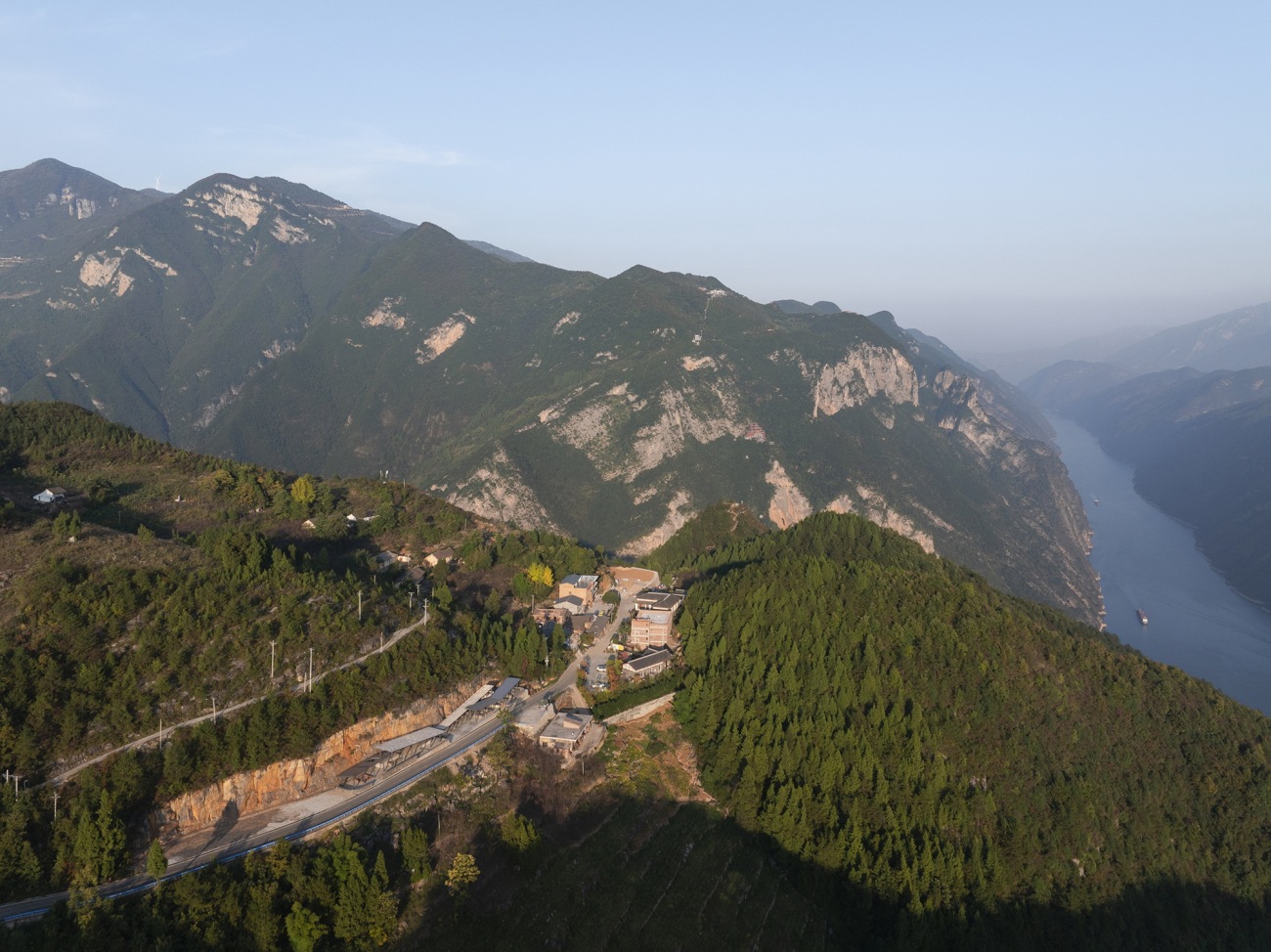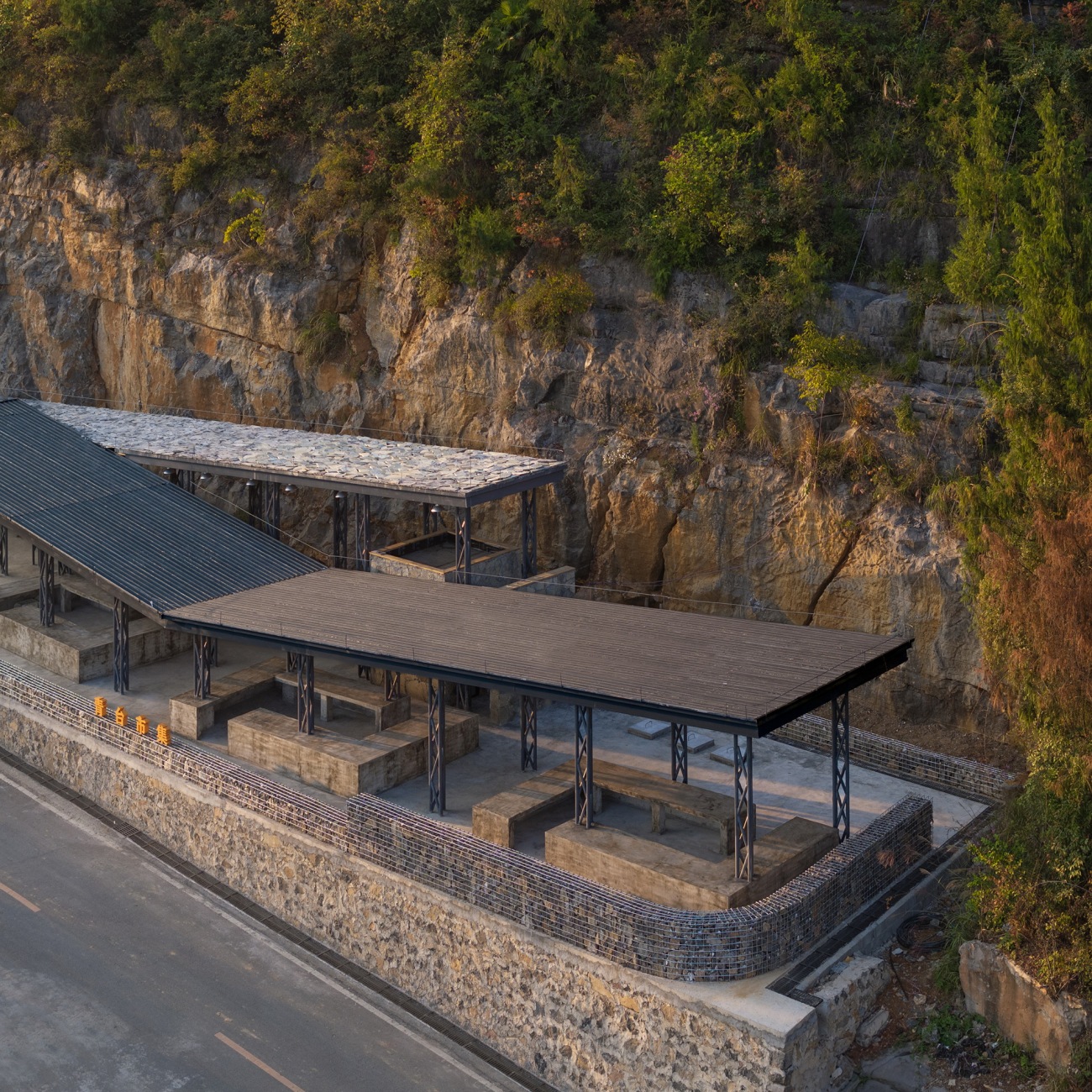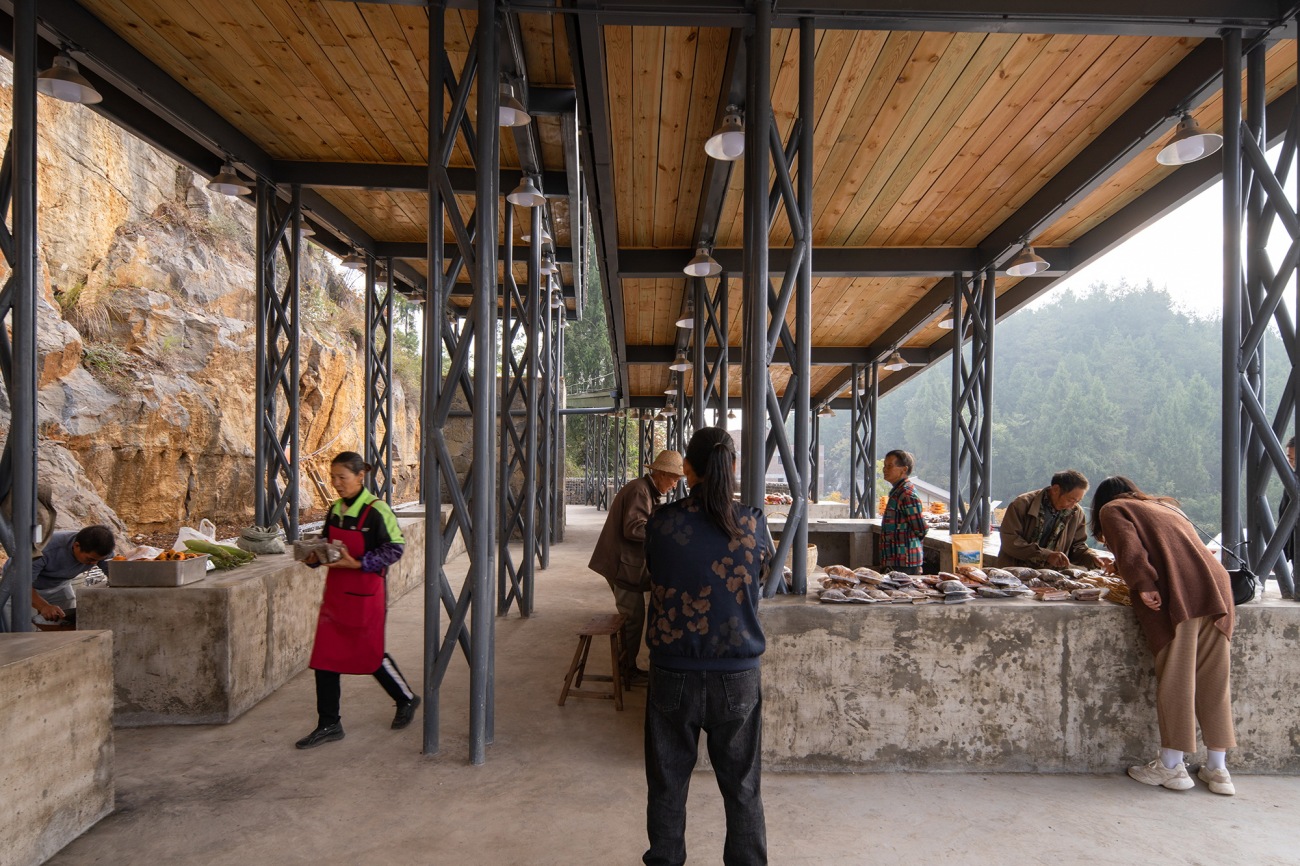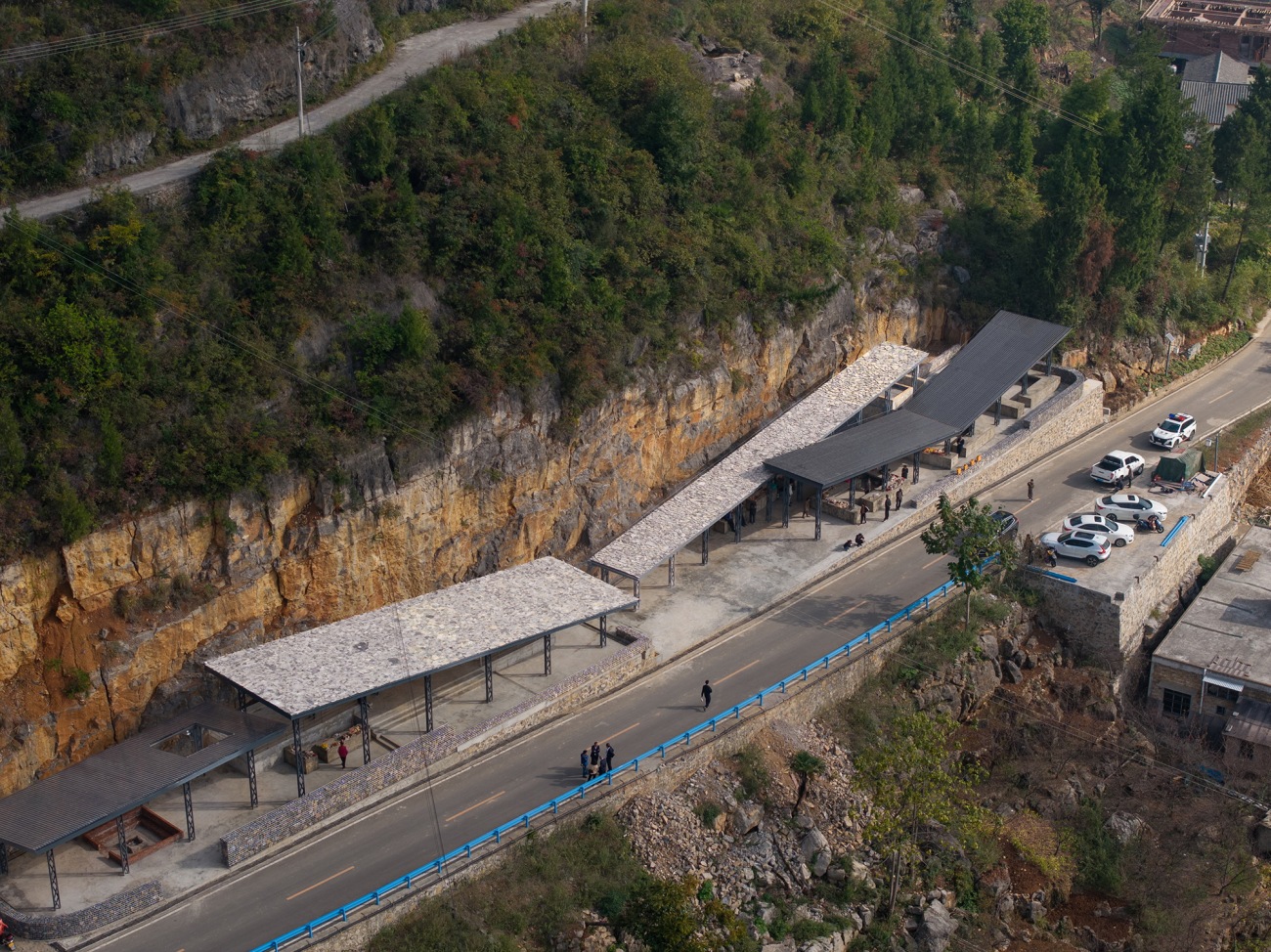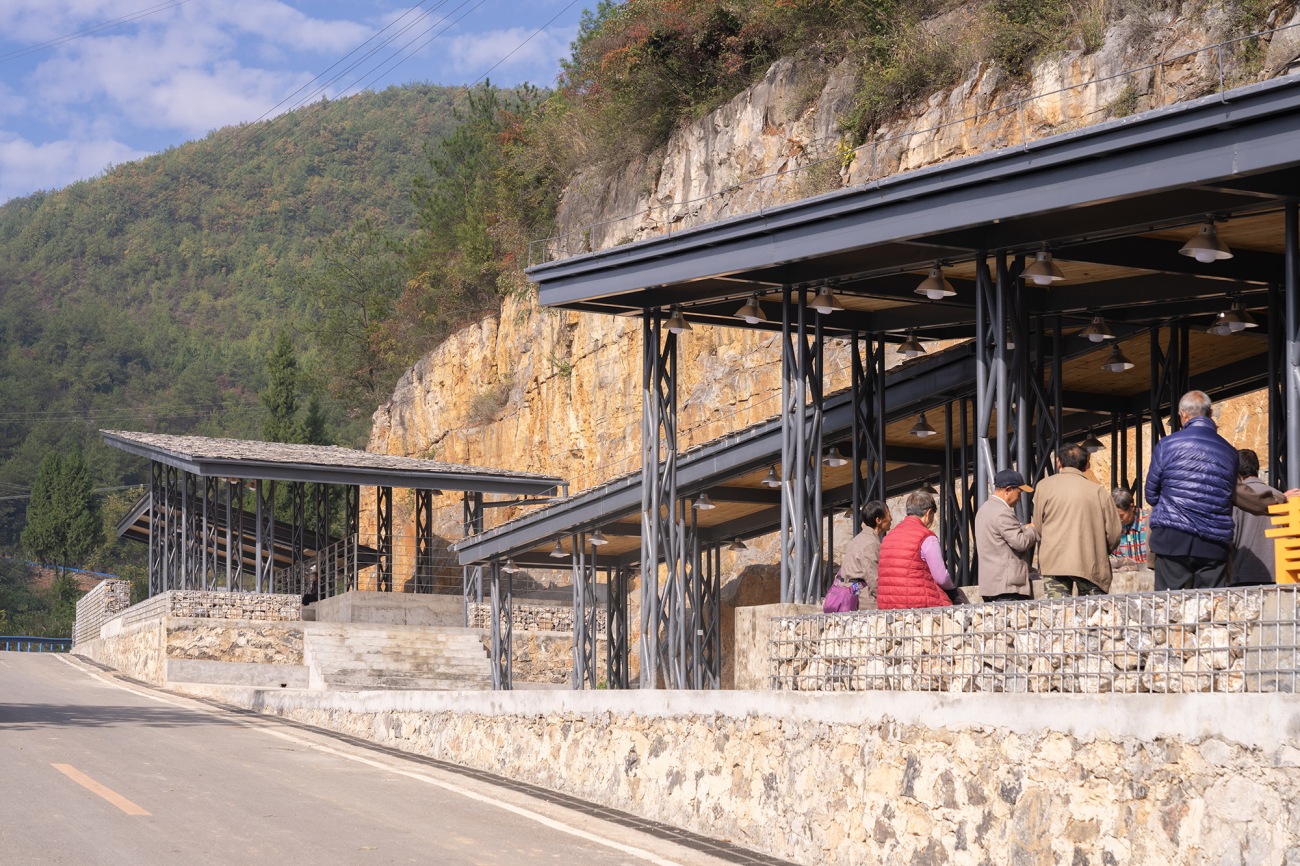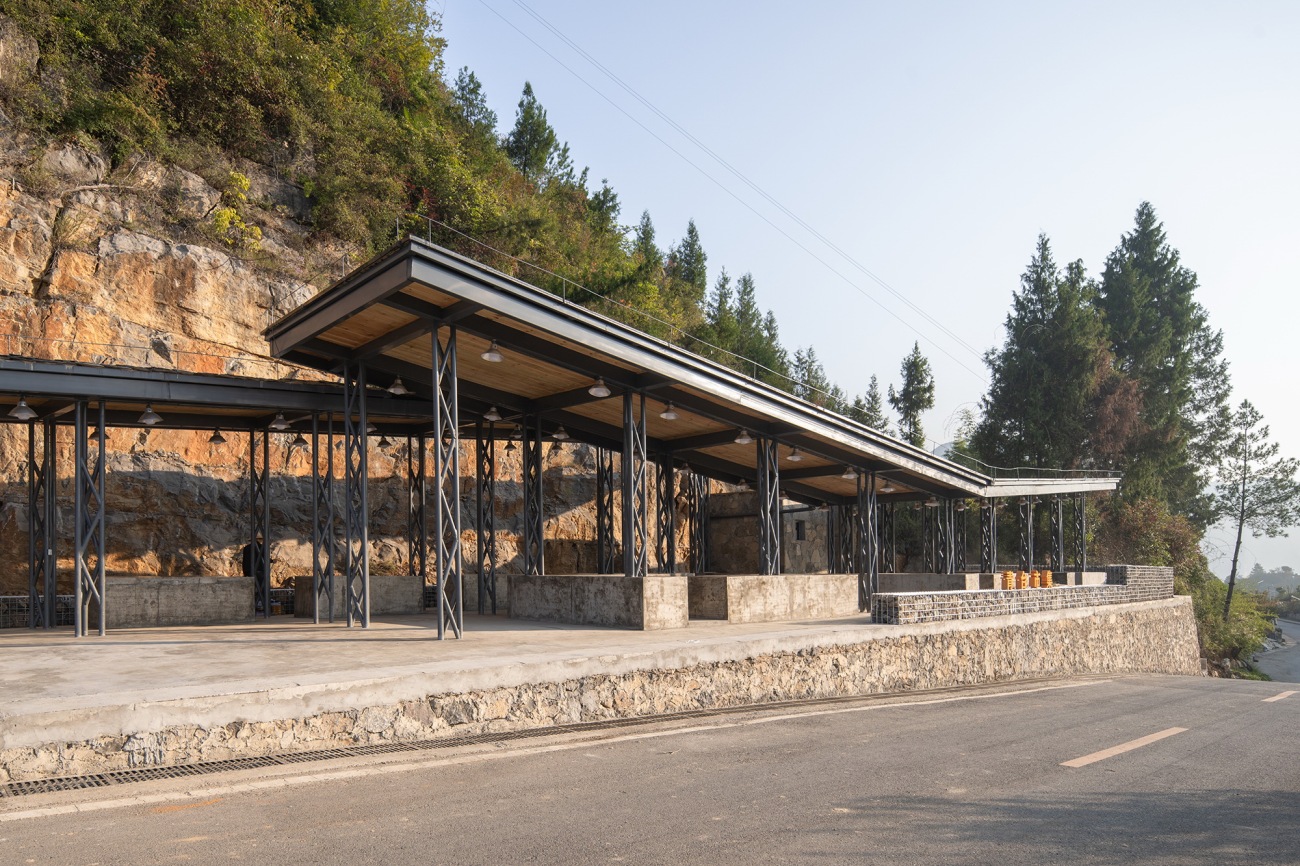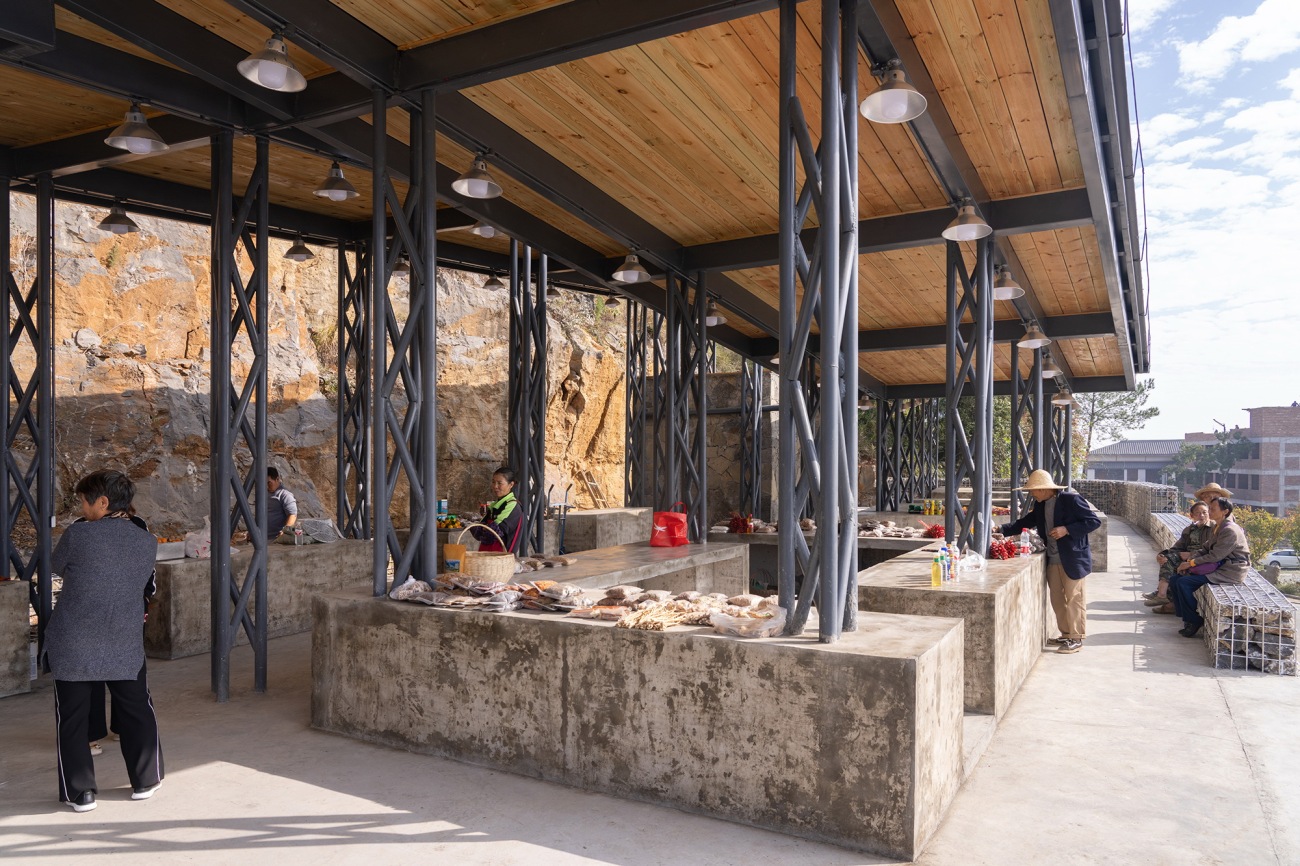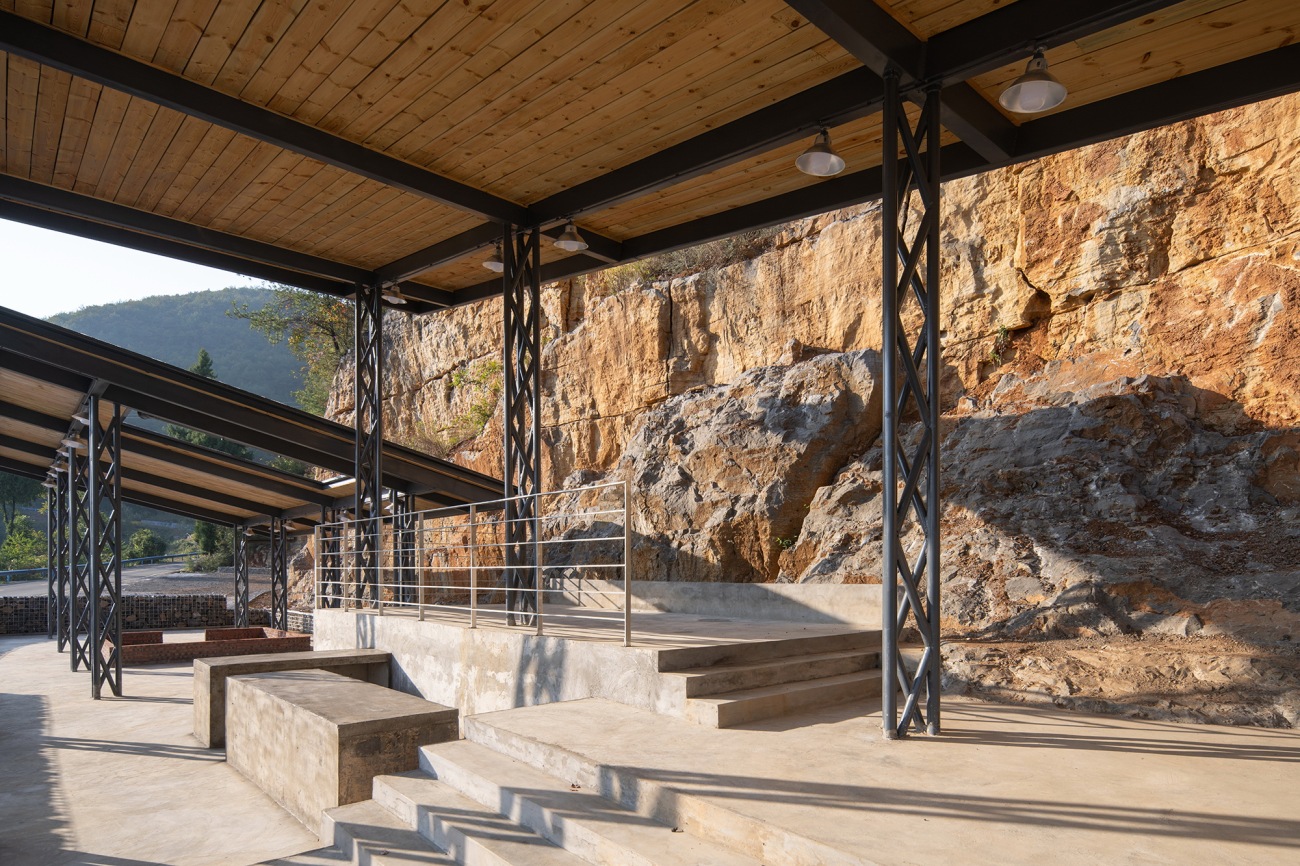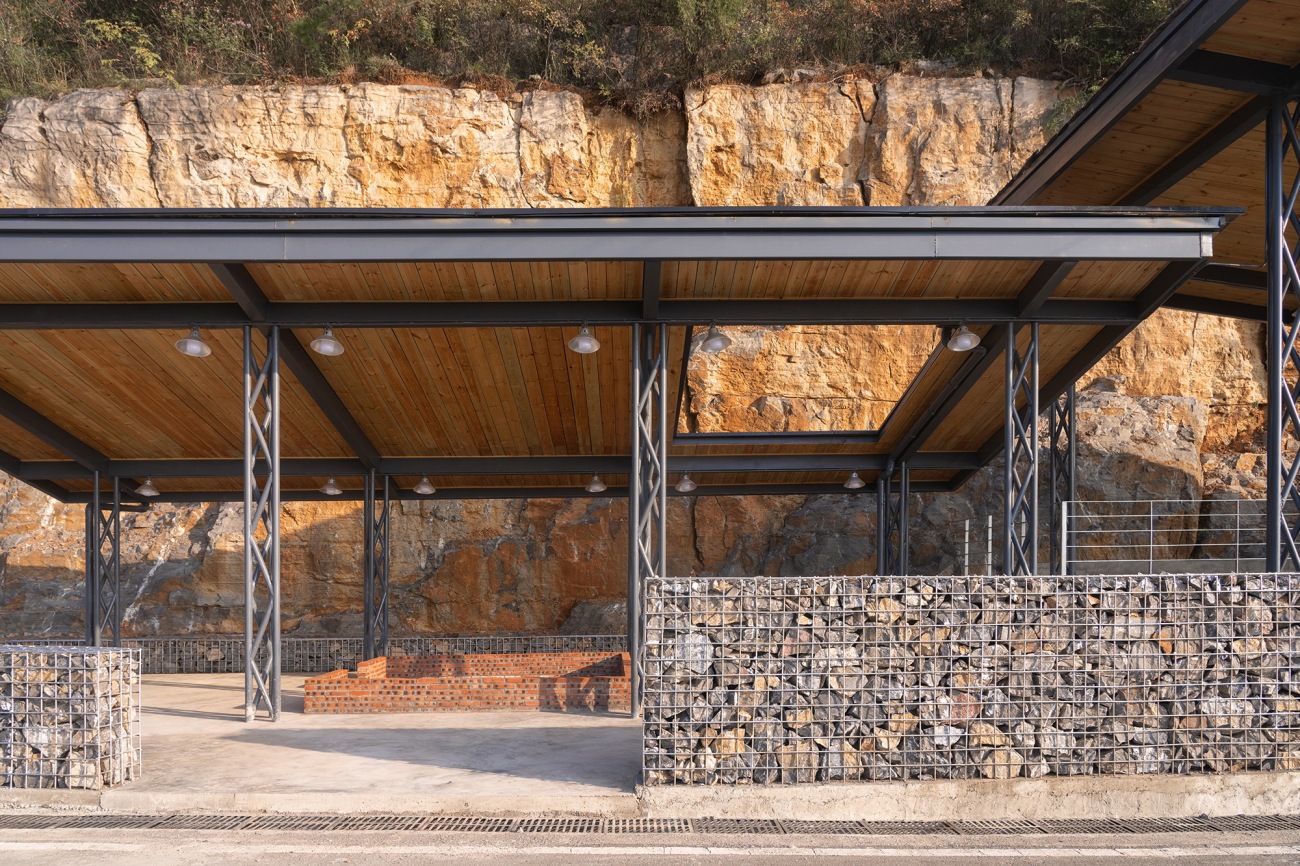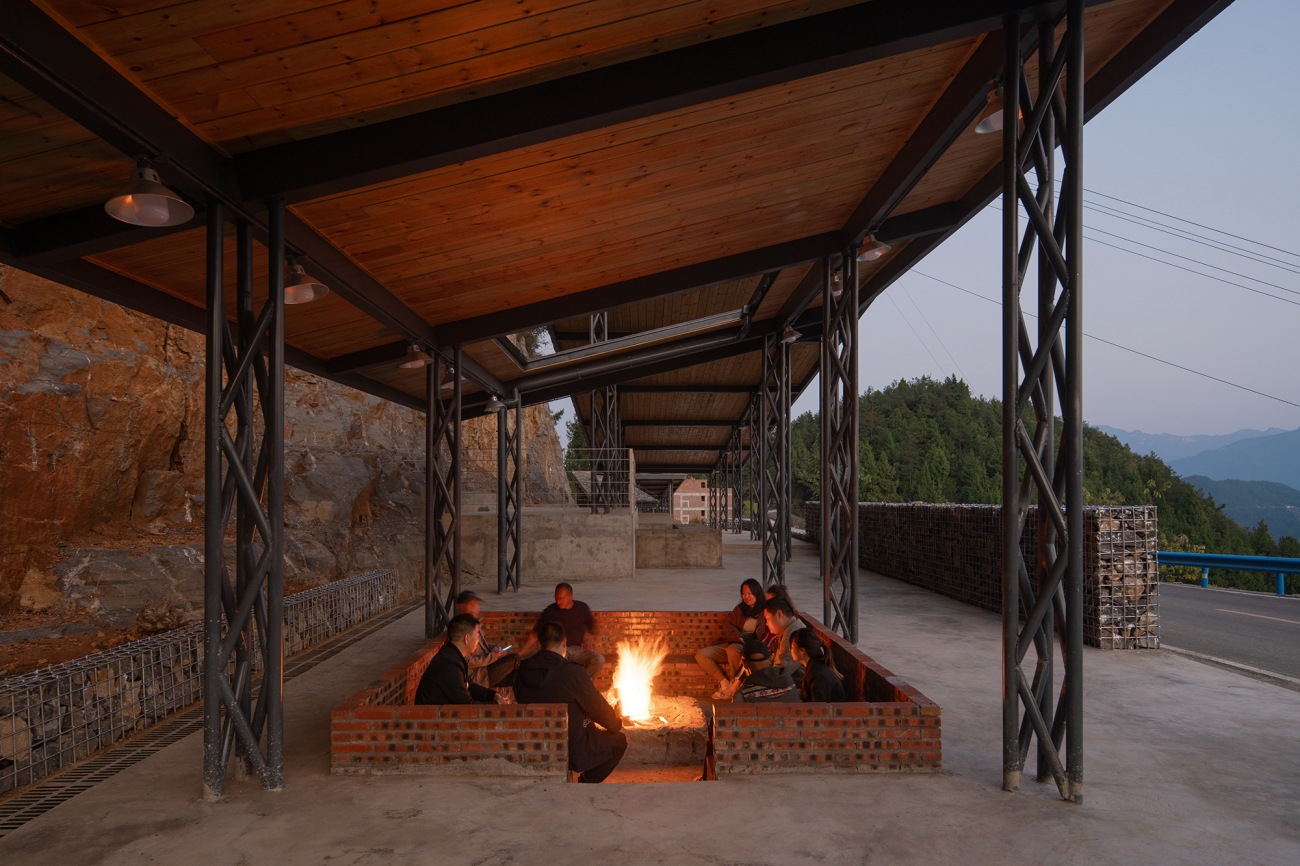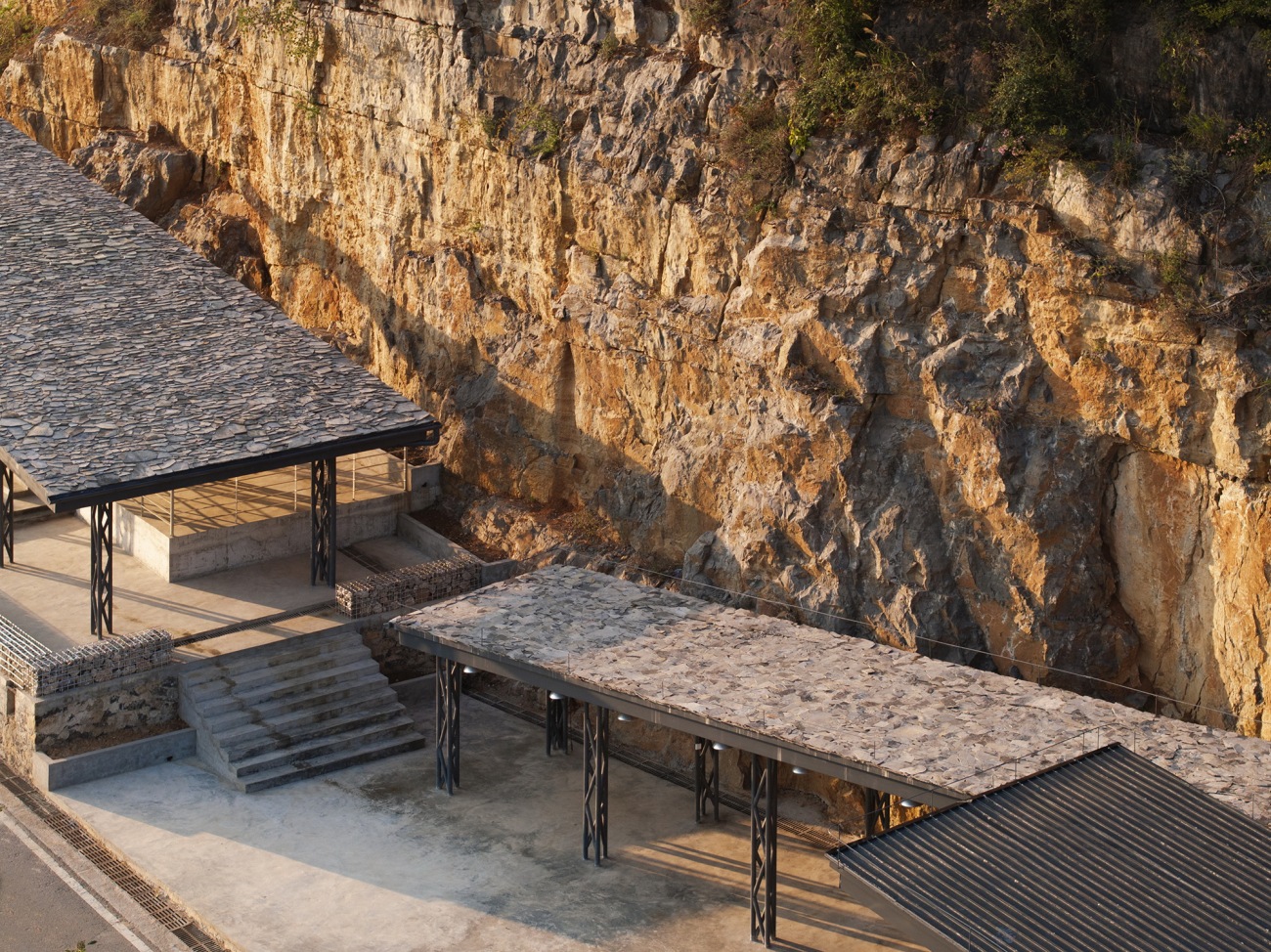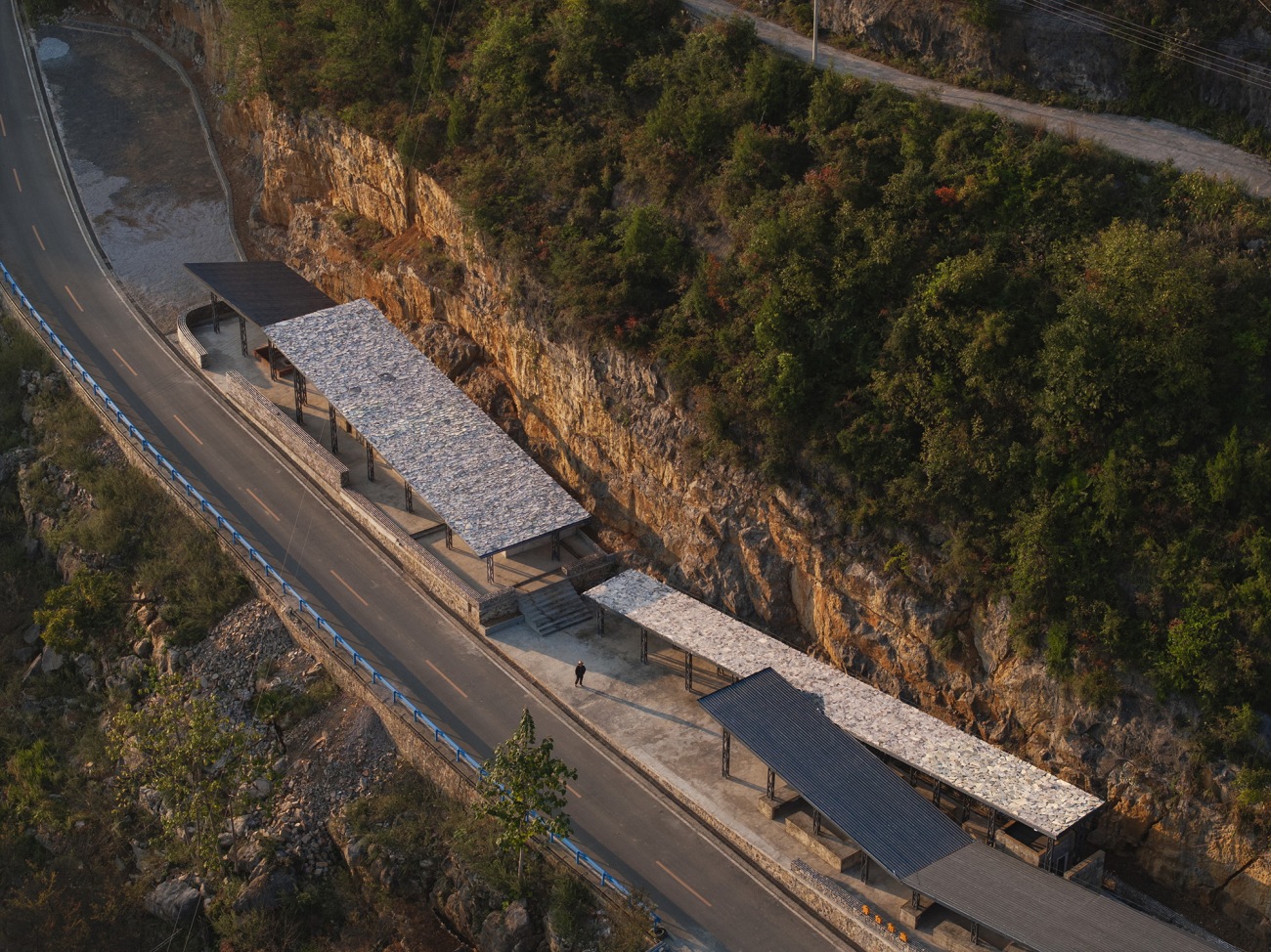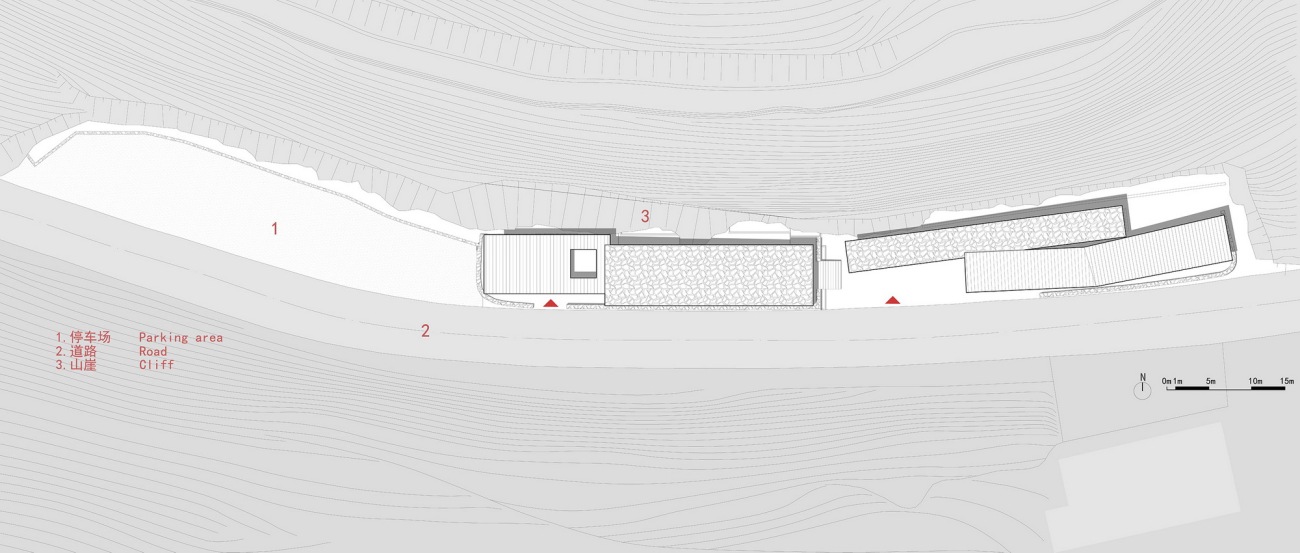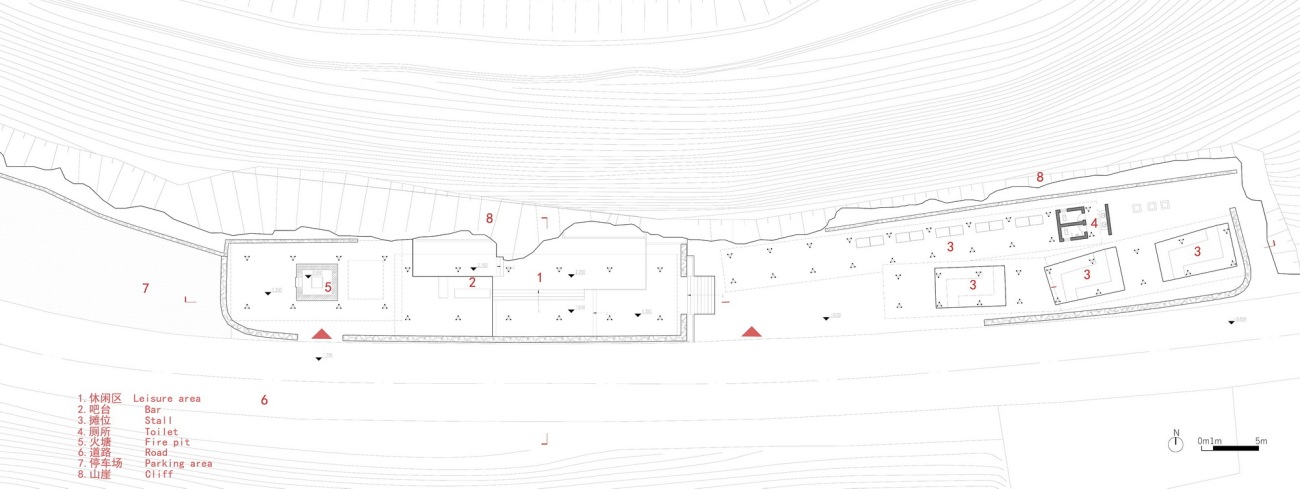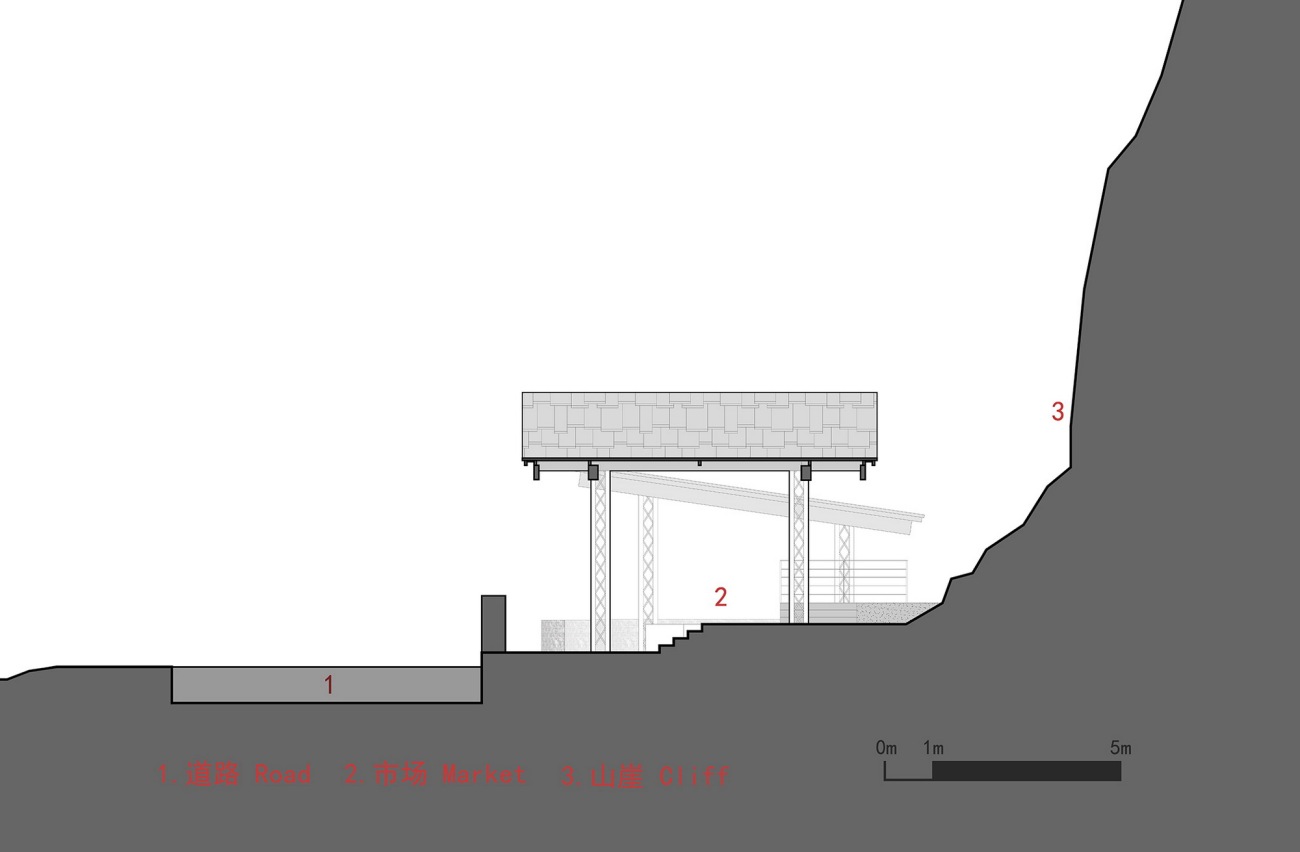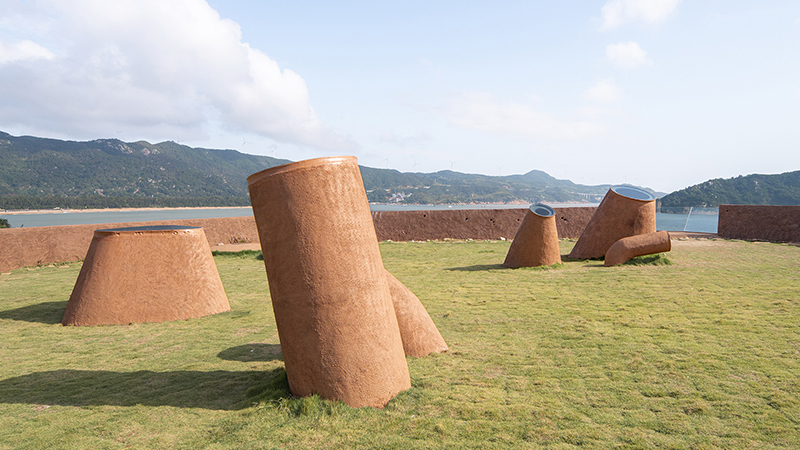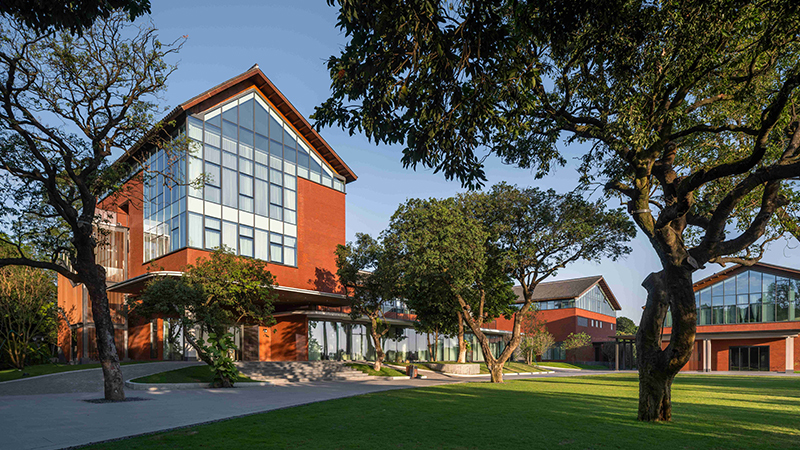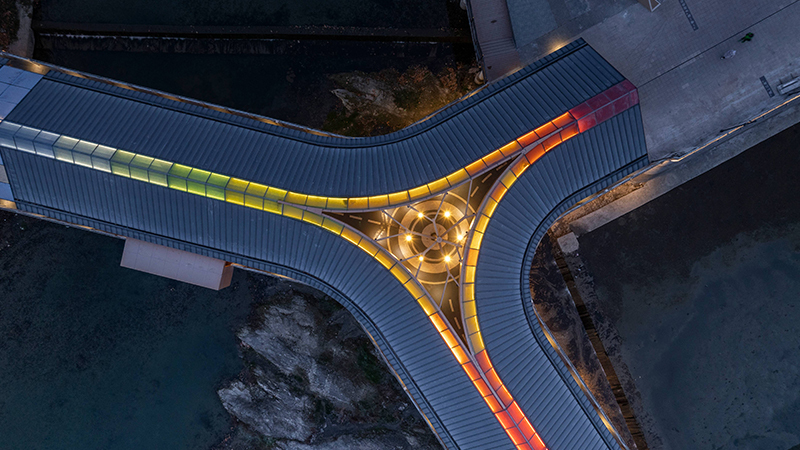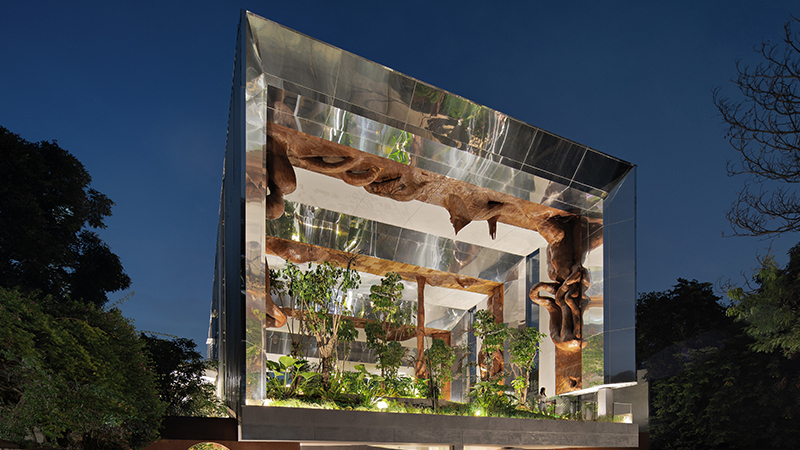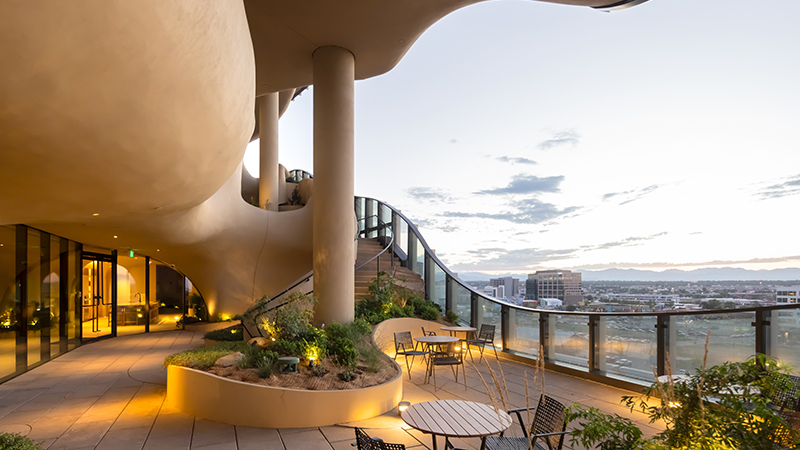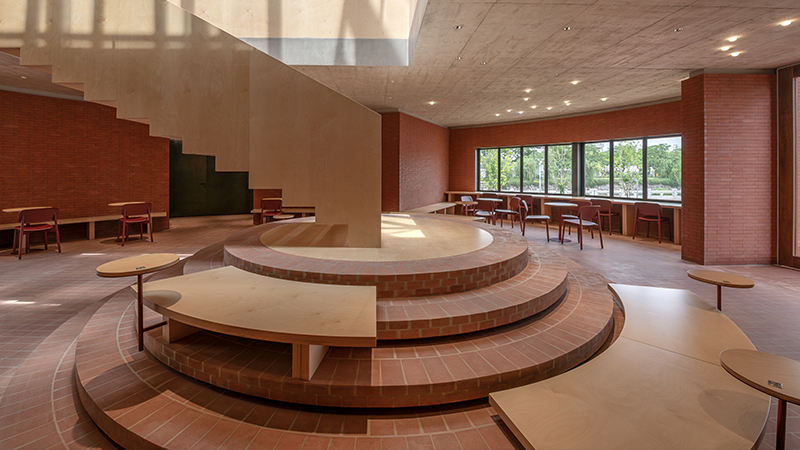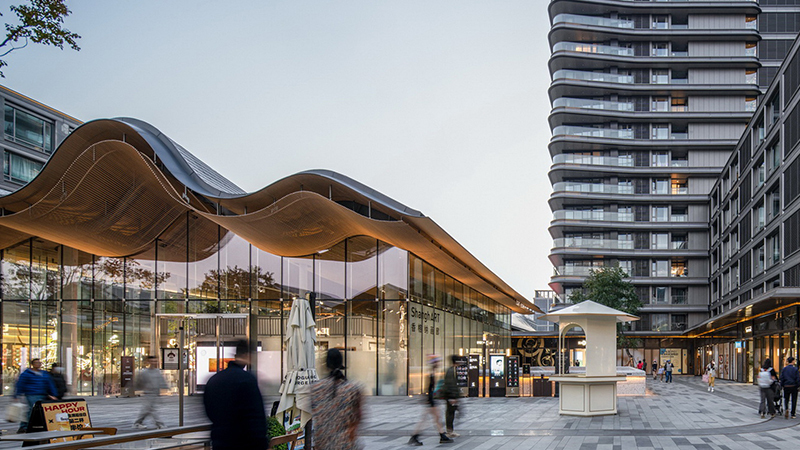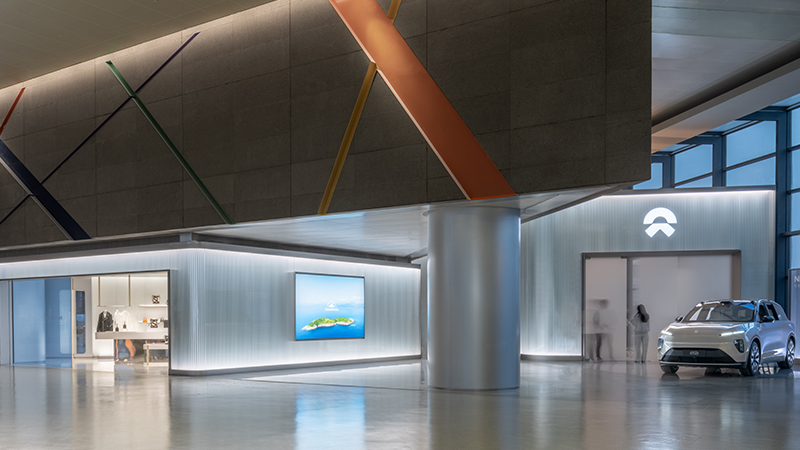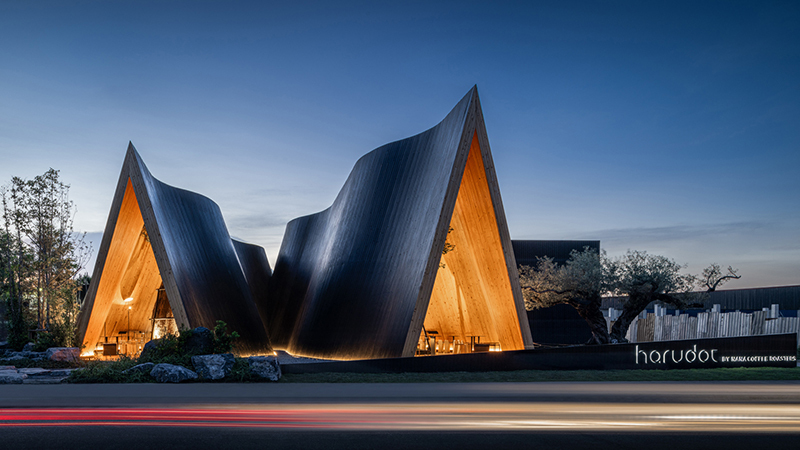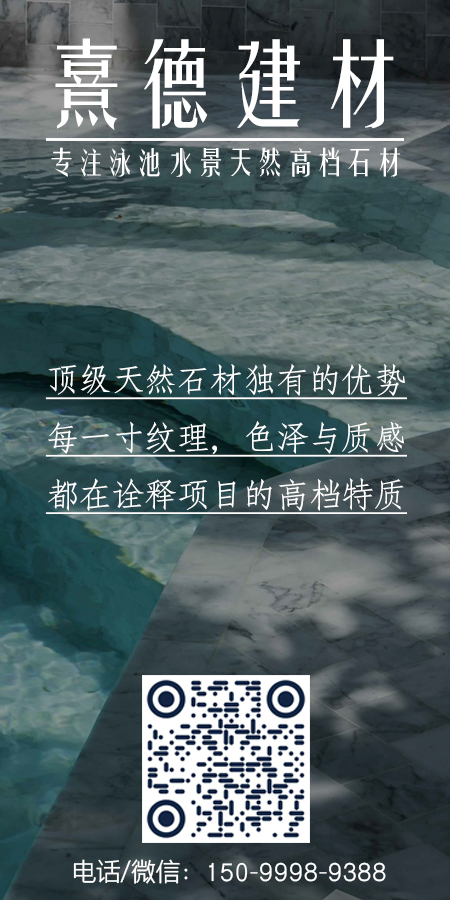场地与缘起:
Venue and Origin:
青台市集位于重庆市巫山县建平乡青台村一社村民组,场地是村口外的一处闲置采石场,闲置前用于开采铺设路基用的碎石。采石场与公路平行,形状狭长,因采石留下的石壁基本平整,自然岩石表面具有很强的质感,成为场地明显的视觉特征。
Qingtai Market is located in the village group of Qingtai Village, Jianping Township, Wushan County, Chongqing. The site is an idle quarry outside the village entrance, which was previously used for mining and laying gravel for the roadbed. The quarry is parallel to the highway and has a narrow and elongated shape. Due to the fact that the stone walls left by the quarry are basically flat, the natural rock surface has a strong texture, which becomes a clear visual feature of the site.
建造一座市集的原因来自村民生活和文旅的双重需求。青台村一社位于巫山神女峰景区的核心地段。村内设有两个观景台,是观看巫峡神女峰和人民币五元取景地的最佳位置。长期以来此处的团客数量都非常多,但这些客流在区内的停留时间很短,基本是传统的团队拍照式旅游模式,因此并没有给当地村民带来实际利益。经过调研,建筑师发现了如下现象和问题:其一,两个观景台形式老旧,缺乏服务文旅的休憩空间,也没有零售或者餐饮设施,游客体验感差,且无法形成二次消费。其二,现状村民有售卖货品的诉求,但村中没有相应的空间,村民只能沿街摆摊售卖土特产品。其结果是,条件简陋且影响交通,有一定的安全隐患。三,村庄建设用地少,村中没有公共空间,村民的交流少,几乎没有公共活动。
The reason for building a market comes from the dual needs of villagers' daily life and tourism. Qingtai Village is located in the core area of Wushan Shennv Peak Scenic Area. There are two observation decks in the village, which are the best locations for viewing the Wuxia Divine Maiden Peak and the RMB five yuan shooting location. For a long time, there have been a large number of group tourists in this area, but their stay in the area is very short, and they basically follow the traditional team photo based tourism mode, so they have not brought actual benefits to the local villagers. After research, the architect discovered the following phenomena and problems: firstly, the two observation decks are outdated in form, lacking leisure space for cultural and tourism services, as well as retail or dining facilities, resulting in poor tourist experience and inability to form secondary consumption. Secondly, the current situation is that villagers have a demand to sell goods, but there is no corresponding space in the village. Villagers can only set up stalls along the street to sell local specialty products. The result is that the conditions are rudimentary and affect traffic, with certain safety hazards. Thirdly, there is limited land for village construction, no public space in the village, little communication among villagers, and almost no public activities.
鉴于次,建筑师与当地政府和村民商讨后决定在村口采石场区域建造一处集市,来解决以上的矛盾。
In view of this, the architect, after discussing with the local government and villagers, decided to build a market in the quarry area at the village entrance to resolve the above conflicts.
设计理念:实用的浪漫
Design Concept: Practical Romance
选择在采石场区域建设市集是基于如下的思考:其一,此地村庄用地紧张,使用采石场可不占用农地或者村庄内村民自留用地;其二,采石场位于村口外,在此处建设市集既可以和未来的停车场相结合,又可形成入村的标志物;其三,市集修复了因采石留下的“生态疤痕”,实现了采石场的“复绿”。
The decision to build a market in the quarry area is based on the following considerations: First, land in the village is scarce, and utilizing the quarry avoids occupying farmland or villagers’ privately owned land. Second, the quarry is located just outside the village entrance, making it an ideal location for a market that can integrate with a future parking lot while also serving as a landmark for the village entrance. Third, the market helps repair the “ecological scars” left by quarrying, restoring greenery to the site.
功能上,市集沿场地长向布置,分为三个区域:靠近村庄的售卖区、中段的休憩区和距离村庄最远的停车区。游客在距离村庄较远的地方上下车,步行经过市集进入村庄,最终到达观景台;在观看完神女峰后,返回途中会再次路过市集,购物、休憩,然后上车离开。这样的安排既符合流线组织,满足了村民与外来游客商品买卖、休息交流的刚需,又增加了现有停车场的面积,为未来的文旅发展提供了拓展空间。
The market is arranged linearly along the site and divided into three zones: a sales area near the village, a leisure area in the middle, and a parking area farthest from the village. Tourists arrive and disembark at a distance from the village, then walk through the market to enter the village and ultimately reach the observation deck. After viewing Goddess Peak, they pass by the market again on their way back, where they can shop, rest, and then depart. This arrangement aligns with the circulation flow, addressing the essential needs of both villagers and tourists for trade, rest, and social interaction, while also expanding the existing parking area to accommodate future tourism development.
售卖区设有固定摊位和临时摊位场地,可以满足不同规模的售卖需要。固定摊位设有桌案,供村民摆放货品,桌案的尺度根据人的行为设计,保证了良好的使用效果。低矮的围墙可供村民和顾客小坐休息。中段的休憩区根据地形分为几个不同高度的平台,此处正好有部分岩石突出石壁,建筑师刻意保留了这些突出的石头,并将之与平台结合在一起,相互咬合,形成了独特的场景。为了满足游客和当地人的不同需要,休憩区设有水吧台和下沉的烧烤区,可以为简单的餐饮提供支持。
The sales area includes both fixed and temporary stalls to accommodate vendors of different scales. Fixed stalls are equipped with counters designed based on human ergonomics to ensure usability, while low walls provide seating for both villagers and visitors. The leisure area in the middle is divided into multiple platforms of varying heights, following the natural terrain. Some rocks protrude from the quarry walls, which the architects deliberately preserved and integrated with the platforms to create a unique spatial experience. To meet the needs of both tourists and locals, the rest area includes a refreshment bar and a sunken barbecue zone, providing support for casual dining.
在满足基本功能之余,市集的建筑形式也力求个性:建筑师首先对采石场的石壁进行了清理,在清除浮石的基础上,保留了原貌的肌理和质感,使之成为市集的背景和空间表达的重要组成部分。市集是一个半开放空间,屋顶采用单坡顶、反向双坡顶的形式,起坡方向也不同,这让建筑既有传统民居的影子,又具有当代特征。为消减尺度,建筑被“化整为零”,碎片化的布局让市集与周边民宅在尺度上保持一致。屋顶略显夸张的上翘形式,让市集看上去很轻盈;光从屋顶之间的缝隙照入,也给空间增添了戏剧性的效果。不高的挡墙让市集内部和街道之间保持视线上的通透,让市集始终具有一种开放欢迎的姿态。
Beyond its functional role, the market’s architectural form seeks individuality. The architects first cleaned the quarry walls, removing loose stones while preserving their original texture, allowing the rugged rock face to become an integral part of the market’s spatial and aesthetic expression. The market is designed as a semi-open space with single-sloped and inverted double-sloped roofs, oriented in varying directions. This design creates a dialogue between traditional residential forms and contemporary architectural elements.
To reduce the perceived scale, the buildings are fragmented into smaller units, maintaining visual harmony with the surrounding village houses. The slightly exaggerated upward tilt of the roofs gives the market a sense of lightness, while the interplay of light filtering through the roof gaps adds a dramatic effect to the space. The low parapet walls ensure visual permeability between the market and the street, reinforcing its open and inviting character at all times.
材料与工艺:就地取材,学习日常
Materials & Craftsmanship: Local Sourcing, Learning from the Everyday
在材料选择上,建筑师力求在地性和现代性的结合,乡土材料和工业材料的交替使用,让建筑既显得轻松,又适当的陌生化。
In material selection, the architects sought a balance between local authenticity and modernity, alternating between traditional rural materials and industrial components to create a market that feels both familiar and refreshingly new.
屋面采用了金属屋面和石板瓦。两种材料一个平整、一个粗糙,结合在一起,让集市的建筑形象多变和有趣。与石板相呼应,围墙也使用了石块作为主要材料。建筑师没有采用传统的毛石磊筑工艺,而采用了更现代,施工更便捷的石笼工艺。石板和石笼的使用既是对场地原功能——采石场的回应,也充分考虑了造价和乡村施工条件的限制。
The roofing combines metal sheets and slate tiles—one smooth and refined, the other rough and textured. This contrast adds visual interest and variety to the market’s architectural identity. Complementing the slate, the walls are built with stone. Instead of traditional rough-stone masonry, the architects opted for a modern gabion wall system, which is not only easier and faster to construct but also aligns with the site’s history as a former quarry. This approach considers both cost and the practical constraints of rural construction.
市集的主体为钢结构。在柱子的设计上,建筑师从当地村民自建房中摄取了营养。在调研中建筑师发现当地村民在处理较高的柱子时,并没有使用常规的方钢或者工字钢单柱,而是将三根相对更细的钢管围成三角形,中间用腹杆焊接,形成类似桁架的构造。当地人说,这样的处理造价更便宜,也更好的解决了柱子的挠度问题。建筑师觉得这样的处理非常具有乡土智慧,于是借鉴了这种做法,将之运用到市集的建造中。
The market’s structure is made of steel, but its column design draws inspiration from local self-built houses. During site research, the architects observed that rather than using standard square steel or I-beam columns for taller structures, villagers preferred a more economical and effective solution: arranging three slender steel pipes into a triangular formation and welding cross braces in between, forming a truss-like structure. This method, as locals explained, reduces costs while improving structural stability by minimizing deflection. Recognizing the ingenuity of this rural construction technique, the architects incorporated it into the market’s design.
完成后,钢柱、金属屋面、石板瓦和石笼形成了一套自洽的材料语言,市集看上去轻松但不失特点。
The completed market integrates steel columns, metal roofing, slate tiles, and gabion walls into a cohesive material language. The result is a structure that feels light, practical, and distinctive, blending seamlessly into its rural context while maintaining a unique architectural character.
结语和反思:
Conclusion and Reflection:
巫山是传统的旅游县,巫峡、神女峰等景点也是世界级的旅游IP,但随着游客出行和体验方式的改变,传统的旅游模式和当下游客诉求之间的矛盾逐渐凸显,游客带来的红利在迅速消失。与此同时,与景区紧密相关的乡村建设也面临挑战,村民并没有从文旅产业中获得充分的利益,自身经济状况也不好,如何让文旅产业和乡村建设联动?如果满足游客体验升级的同时,给村民带来实惠?这些是急需解决的命题。
Wushan is a traditional tourist county, with world-class attractions such as the Wuxia Gorge and Goddess Peak. However, as tourism and visitor experiences evolve, the gap between traditional tourist models and current visitor demands has become increasingly evident. The benefits brought by tourists are quickly diminishing. At the same time, rural construction, closely tied to the scenic areas, is facing challenges. Villagers have not gained sufficient benefits from the tourism industries, and their economic situation remains poor. How can we create a connection between the tourism industry and rural development? How can we upgrade visitor experiences while providing tangible benefits to the local community? These are urgent questions that need to be addressed.
青台市集以轻松的姿态呈现,在满足村民售卖货物,游客休憩和相互交流的同时,又巧妙的对采石场进行了生态修复。项目规模不大,造价也很有限,但建筑师希望它能“以小博大”,为青台村赋能,成为该区域文旅和乡村建设融合的起点。
The Qingtai Market presents a light, practical solution that meets the needs of villagers for selling goods, and provides a space for tourists to rest and interact, all while cleverly restoring the ecological scars left by the quarry. Though the project is small in scale and limited in cost, the architects hope it can “punch above its weight”, empowering Qingtai Village and serving as a starting point for the integration of tourism and rural development in the region.
▽总图
▽立面图
▽平面图
▽剖面图
项目信息:
项目名称:青台市集
项目地点:重庆市巫山县建平乡青台村一社
业主:重庆市巫山县建平乡人民政府
建筑设计:三文建筑/何崴工作室(https://3andwichdesign.com)
主创建筑师:何崴
设计团队:王梓亦、孟祥婷、支海洋、王俊、张宏雨(实习)
合作单位:上海中福建筑设计院有限公司
场地面积:1440平米
建筑面积:270平米
设计时间:2024年2-4月
建成时间:2024年9月
摄影:DONG建筑影像(www.dongimage.com)
Project Information:
Name of the project: Qingtai Market
Location: Village group 1 of Qingtai Village, Jianping Township, Wushan County, Chongqing
Owner: Jianping Township People's Government
Architectural Design: 3andwich Design/He Wei Studio(https://3andwichdesign.com)
Lead architects: He Wei
Team: Wang Ziyi, Meng Xiangting, Zhi Haiyang, Wang Jun, Zhang Hongyu
Collaborators: Shanghai Zhongfu Construction Design Institute Co., Ltd.
Site area: 1440 sqm
Construction area: 270 sqm
Design time: Feb.- Apr. 2024
Completion time: Sep. 2024
Photography: DONG Image(www.dongimage.com)
更新日期:2025-02-19 17:37:31
非常感谢 三文建筑 带来的精彩项目, 查阅更多Appreciations towards 3andwich Design for sharing wonderful work on hhlloo. Click to see more works!
